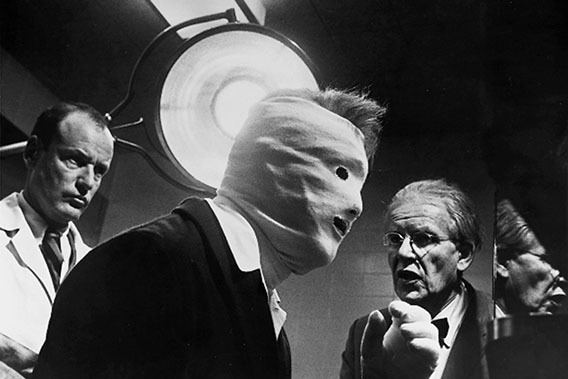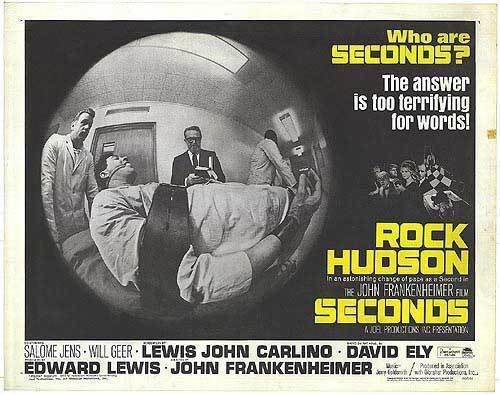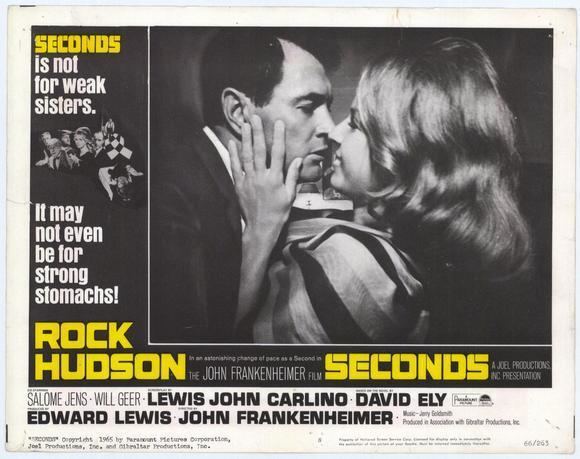Seconds (1966 film)
8.4 /10 1 Votes
90% Rotten Tomatoes Genre Drama, Horror, Mystery Country United States | 7.7/10 IMDb Duration Language English | |||||||||||||||||||||||||||||||||
 | ||||||||||||||||||||||||||||||||||
Release date October 5, 1966 (1966-10-05) Based on Seconds, a novel by David Ely Initial release October 5, 1966 (New York City) Cast (Antiochus \'Tony\' Wilson), (Nora Marcus), (Arthur Hamilton), (Old Man), (Mr. Ruby), (Dr. Innes) Similar movies Mad Max: Fury Road , Jurassic World , John Wick , Furious 7 , Blackhat , Taken 3 | ||||||||||||||||||||||||||||||||||
Seconds 1966
Seconds is a 1966 American science fiction drama film directed by John Frankenheimer and starring Rock Hudson. The screenplay by Lewis John Carlino was based on Seconds, a novel by David Ely. The film was entered into the 1966 Cannes Film Festival and released by Paramount Pictures. The cinematography by James Wong Howe was nominated for an Academy Award.
Contents
- Seconds 1966
- Rock hudson seconds trailer 1966
- Plot
- Production
- Historical context
- Reception
- Awards
- Home video
- References

In 2015, the United States Library of Congress selected the film for preservation in the National Film Registry, finding it "culturally, historically, or aesthetically significant."

Rock hudson seconds trailer 1966
Plot

Seconds is a mystery dealing with the obsession with eternal youth and a mysterious organization which gives people a second chance in life.

Arthur Hamilton (John Randolph) is a middle-aged man whose life has lost purpose. He's achieved success, but finds it unfulfilling. His love for his wife has dwindled and he seldom sees his only child. Through a friend, a man he thought was dead, Hamilton is approached by a secret organization, known simply as the "Company" which offers him a new life.

Upon arriving for a meeting, Hamilton arrives at a meat packing plant. He is given workman overalls and hat, then exits the facility out a different door where he is next seated inside the back of a truck which proceeds to another building. He disappears into a large complex filled with dark, empty hallways where he awaits his transformation. The Company gives Hamilton the body of a young man (Rock Hudson) through plastic surgery and a new identity, namely 'Antiochus "Tony" Wilson'. He later discovers this identity has been taken from someone who recently passed on.

He is resettled into a community filled with people like him who are "reborns". Eventually, Hamilton decides the new life isn't what he wants. He contacts the Company, letting them know he wants a different identity and they seem to agree. It turns out to be a lie and Hamilton learns as he is wheeled to the operating room, before being sedated, that he is to be killed.
Production
The director of photography for Seconds was James Wong Howe, who pioneered novel techniques in black-and-white cinematography, and whose career spanned nearly five decades. He was nominated for an Oscar at the 39th Academy Awards for his work on the film. Seconds was Frankenheimer and Howe's last film in black-and-white.

Rock Hudson was five inches taller than his movie counterpart, John Randolph; the difference in their heights was worked around with carefully chosen camera angles. Hudson and Randolph also spent a good deal of time together before production began, allowing Hudson to model Randolph's mannerisms, to resemble him more closely.
In Frankenheimer's commentary on the DVD, he notes:
The opening titles were designed by Saul Bass, using Helvetica set in white over optically warped black-and-white motion picture photography.
Historical context
John Frankenheimer directed Seconds just after the period he worked on his most notable films, Birdman of Alcatraz (1962), The Manchurian Candidate (1962), and Seven Days in May (1964). These last two films together with Seconds are sometimes known as Frankenheimer's paranoia trilogy.
The "reborns" of the plot are ironically paralleled in a different context—three of the principal actors (Jeff Corey, Will Geer, and John Randolph) were proscribed from Hollywood films during the "Blacklist" years of the 1950s.
Seconds is also known for its connection to American songwriter Brian Wilson of The Beach Boys, who was strongly affected by the film during sessions for the concept album Smile. After arriving late to the theater, he appeared to be greeted with the onscreen dialogue, "Come in, Mr. Wilson," believing for some time that the film was directly based on his recent traumatic experiences and intellectual pursuits, going so far as to note that "even the beach was in it, a whole thing about the beach." Wilson soon after ceased Smile recording sessions for the next several decades. The movie reportedly frightened him so much that it wouldn't be until 1982's E.T. the Extra-Terrestrial that he'd ever visit a movie theater again.
Reception
Seconds premiered on October 5, 1966. It did poorly on its initial release, but has since become a cult classic.
A reviewer in Time magazine commented: "Director John Frankenheimer and Veteran Photographer James Wong Howe manage to give the most improbable doings a look of credible horror. Once Rock appears, though, the spell is shattered, and through no fault of his own. Instead of honestly exploring the ordeal of assuming a second identity, the script subsides for nearly an hour into conventional Hollywood fantasy. [...] Seconds has moments, and that's too bad, in a way. But for its soft and flabby midsection, it might have been one of the trimmest shockers of the year."
Seconds has since gained an overall positive reaction, currently holding a 90% "fresh" rating on Rotten Tomatoes based on 29 reviews. Rotten Tomatoes' consensus reads: "Featuring dazzling, disorienting cinematography from the great James Wong Howe and a strong lead performance by Rock Hudson, Seconds is a compellingly paranoid take on the legend of Faust."
In the film The Pervert's Guide to Ideology, the psychoanalytical Marxist philosopher Slavoj Žižek discusses the film as an example of what happens when desires are fulfilled.
Awards
Home video
Seconds was released on home video for the first time in May 1997. Seconds was released on DVD on January 8, 2002, and later went out of print. The Criterion Collection released a newly restored version of the film on DVD and Blu-ray on August 13, 2013.
